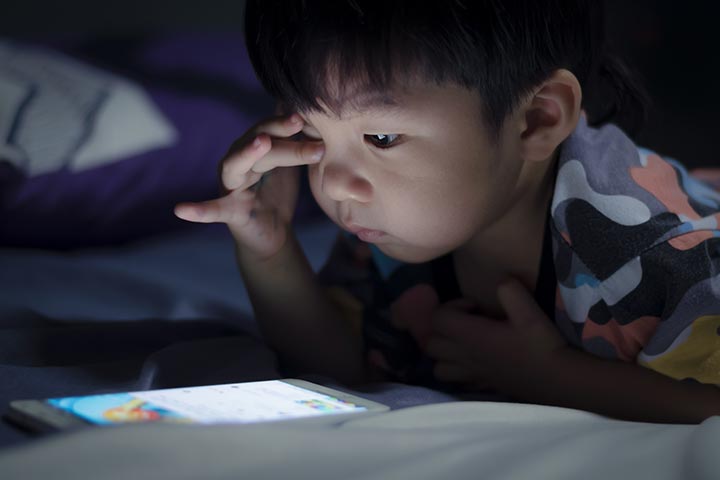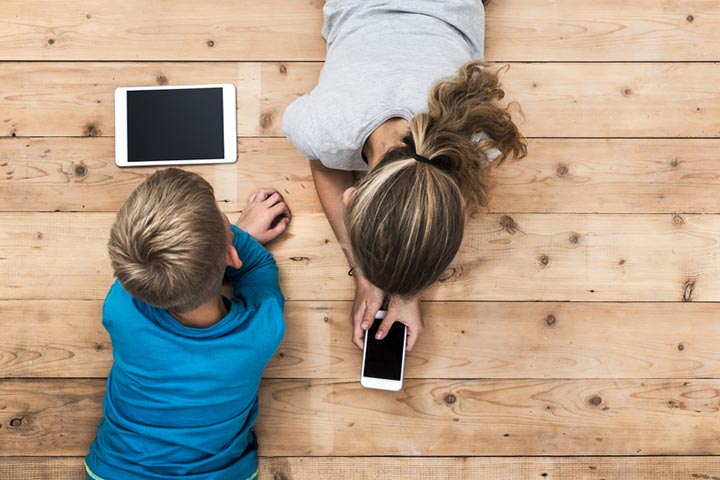
Image: Shutterstock
How do you keep your child engaged when you have too many chores at home? We wouldn’t be surprised if your answer is ‘mobile phones or tabs.’ Parents overburdened with work and home commitments often find this as an easy way to keep the kid busy for a while. This is because the games and videos on mobile phones do not require parental involvement, unlike physical activities.
As much as we sympathize with parents, it does not take away from the fact that the use of mobile phones is still harmful to the kids. Of course, some parents might argue that they do monitor what their kid is watching and even have certain filters in place. Great. But, what about the effects of screen exposure on a child’s eyes?
How Mobile Phones Damage The Eyes
So, how exactly do mobile phones damage your child’s eyes? Here’s the science behind it: the retina of the eye contains photoreceptors that transform the visible light into an electrochemical signal. Human beings are dependent on this process for regulating the daily sleep-wake cycle and image formation.
The personal electronic devices and strong sunlight contain significant amounts of short-wavelength, high-energy blue light. This blue light can damage the retina of the eye if it gets absorbed into the retina. While ultraviolet (UV) light contains comparatively more energy than blue light, it gets absorbed by the crystalline lens and cornea. Thus limiting the retinal exposure (1).
However, the visible blue light can potentially harm the retina as it gets absorbed by some of the photoreceptors and the retinal pigment epithelium (RPE). This generates localized thermal and oxidative stress. Some laboratory studies done on rodents have shown that extended hours of retinal exposure to bright blue light quickened the rates of photoreceptor and RPE death.
现在,阳光和个人设备包含the bright blue light. So, what makes the damage by sun exposure different than the usage of personal devices? The potential damage caused to the human retina by extended exposure to sunlight can be reduced in simple ways. This can be done by making your child wear dark sunglasses that contain UV light filters. Limiting sun exposure during peak hours of the day can also limit the damage to a large extent. Another important factor is that strong sunlight is present neither throughout the day nor the year due to seasonal changes. Of course, this varies depending on which part of the globe you reside.
Blue Light – The Real Villian
Limiting retinal damage caused by the bright blue light can prove to be tad difficult. Firstly, there are no simple devices like sunglasses to protect the eye. While the bright blue light might not be able to damage the retina directly, it can stimulate the blue-light-sensitive ganglion cell photoreceptors. The ganglion cell photoreceptors regulate the circadian rhythm of the body, which is the sleep-wake cycle. Therefore, exposure to personal devices like mobile phones and tablets before bedtime might delay the onset of sleep, worsen the quality of sleep, and hinder alertness the following day.
Thus, to reduce the effect of blue light on the retina and limit sleep disruption, it is highly advisable to avoid giving mobile phones or personal gadgets to your child before sleep. It’s equally important to limit the usage even during the day to get your child out of the habit of binging on mobile phone games (2).
Your child’s eyes are precious and delicate compared to the adult eye. Yet, when blue light from mobile phones can cause potential damage to the adult-eye, then imagine how easily it can damage your little one’s delicate retina. So, protect your child’s eyes from any damage by indulging him/her in more healthy, constructive activities. Do not compromise on your child’s eye health for the sake of a few household chores or work commitments.
















